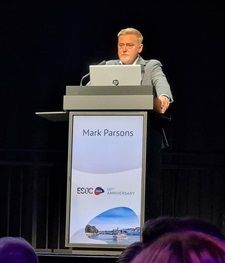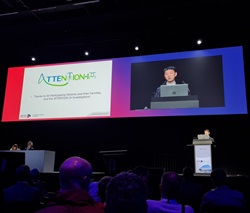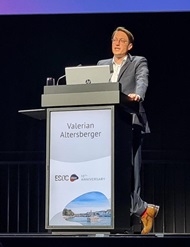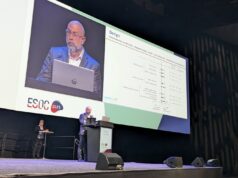
This year’s European Stroke Organisation Conference (ESOC; 15–17 May, Basel, Switzerland) saw a plethora of data on intravenous tenecteplase—from studies spanning Australia, Canada, China, Europe, and beyond—presented for the first time. Fresh findings from the ATTENTION-IA, ORIGINAL, TASTE, TEMPO-2 and TRACE III randomised controlled trials (RCTs) were disclosed, as were a combined analysis of data from the SWIFT DIRECT and EXTEND-IA TNK studies, and a meta-analysis of a total of nine already-published RCTs in this space.
“During ESOC 2024, several trials were presented in which tenecteplase was evaluated versus alteplase,” said Robin Lemmens (KU Leuven, Leuven, Belgium), chair of the ESOC 2024 Conference Planning Committee, speaking to NeuroNews. “Data from trials like TASTE and ORIGINAL were again illustrations of the benefit of tenecteplase, which will likely result in the replacement of alteplase for the treatment of acute stroke. Furthermore, the use of tenecteplase was explored in patients presenting in the later time window and for an additional effect after endovascular treatment. Although not all these results showed improved outcomes in patients treated with tenecteplase, these trials highlighted the shift [in recent] years towards tenecteplase in studying extra indications for thrombolysis. TEMPO-2 provided important evidence that, although thrombolysis is an important treatment option for acute stroke patients with clear functional impairment, it should not be the first treatment for patients with minor stroke. In short, the future of thrombolysis for acute stroke will involve tenecteplase, but not for each clinical scenario, and indications may shift with evidence from trials to come.”
A
TASTE
First to be presented was the international, phase-three TASTE trial, with principal investigator Mark Parsons (University of Newcastle, Callaghan, Australia) reporting that tenecteplase narrowly failed to demonstrate non-inferiority to alteplase—the traditional gold standard for intravenous thrombolysis (IVT)—in intention-to-treat (ITT) analyses. TASTE, which specifically included acute ischaemic stroke patients presenting within 4.5 hours of symptom onset and selected via perfusion imaging, did, however, find tenecteplase non-inferior to alteplase in its per-protocol analysis.
“TASTE is the largest clinical trial ever in stroke to use modern brain perfusion imaging selection in all patients,” Parsons said, also noting that the trial exclusively included patients with a proven tissue target for reperfusion treatment. “Thus, the TASTE results increase confidence that tenecteplase is actually a superior agent [to alteplase] for stroke thrombolysis.”

TASTE was a non-inferiority trial conducted in 35 hospitals across eight countries, with all patients undergoing measurement of salvageable tissue—known as ‘target mismatch’—on brain perfusion imaging, before being randomly assigned to either tenecteplase or alteplase. Its primary endpoint was the proportion of patients without disability (modified Rankin scale [mRS] 0–1) at 90 days. The trial was stopped early in light of positive results from previous tenecteplase trials, with a total of 680 patients having been randomised.
In ITT analysis, the primary endpoint occurred in a numerically higher proportion of patients allocated to tenecteplase (57%) versus alteplase (55.3%), translating into a standardised risk difference of 0.03 and marginally missing the predefined non-inferiority criteria of a lower boundary of −0.03. However, non-inferiority was demonstrated via per-protocol analyses, and the trial also found that safety outcomes including all-cause mortality and symptomatic intracranial haemorrhage (sICH) were comparable between groups. TASTE’s investigators have stated that their results are in line with those from previous tenecteplase trials for acute ischaemic stroke and indicate the drug’s superiority over alteplase—regarding ‘excellent’ three-month recovery—when meta-analysed alongside other studies.
ORIGINAL
Another study featured at ESOC 2024 was the ORIGINAL trial, delivered by Shuya Li (Capital Medical University, Beijing, China), which ultimately deemed tenecteplase statistically non-inferior—but not superior—to alteplase in terms of 90-day mRS 0–1. Some 72.7% of 732 patients treated within tenecteplase and 70.3% of 733 treated with alteplase in the study achieved this outcome, resulting in a non-inferiority risk-ratio (RR) margin of 0.937. Ninety-day mRS score distribution was found to be statistically similar between groups as well.
Also assessing acute ischaemic stroke patients presenting within 4.5 hours of symptom onset, but doing so across 55 sites in China, the trial’s primary endpoint finding of 90-day mRS 0–1 being comparable between the two drugs remained consistent across multiple prespecified subgroups, including age, gender, comorbidities, baseline National Institutes of Health stroke scale (NIHSS) score, time to administration, and whether or not mechanical thrombectomy was performed. In addition, several secondary efficacy endpoints, such as rates of 24-hour major neurological improvement (48% vs 45%) and 90-day mRS 0–2 (80.9% vs 79.9%) were statistically similar between tenecteplase and alteplase, as were safety endpoints including rates of adjudicated sICH events (5.2% vs 5.3%), all-cause mortality (4.6% vs 5.8%), and 90-day mRS 5–6 (6.8% vs 7.8%).
Li’s concluding message on behalf of the ORIGINAL investigators was that these results are consistent with those seen in prior investigator-initiated tenecteplase trials, supporting use of the drug as a “promising alternative” to alteplase as the standard of care in acute ischaemic stroke.
TRACE III
Findings from TRACE III—another Chinese trial evaluating tenecteplase, this time when administered in a later time window of 4.5–24 hours post-stroke—were presented on the same day by Yunyun Xiong (Capital Medical University, Beijing, China). Xiong reported that tenecteplase improved functional outcomes in large vessel occlusion (LVO) stroke patients with salvageable tissue on perfusion imaging and without access to thrombectomy, providing evidence of the benefits the drug can enable in settings where patients do not have immediate access to endovascular treatment.
Conducted across a number of centres in China, TRACE III randomised 516 eligible patients to receive either tenecteplase in the intervention group or standard medical therapy involving aspirin and/or clopidogrel in the control group. Tenecteplase was associated with a higher rate of patients achieving 90-day mRS 0–1, as compared to medical therapy (33% vs 24.2%), leading to a relative RR of 1.37. Mortality at 90 days was comparable between the intervention and control groups, and, while there was a numerically higher rate of sICH observed with tenecteplase (3% vs 0.8%), this did not reach statistical significance.
“The trial demonstrates a clear benefit of intravenous tenecteplase in patients with LVO and tissue at risk of infarction up to 24 hours after symptom onset,” Xiong stated. “These results are important for patients arriving in the late or unknown time window who require interhospital transfer, and in whom there is no guarantee they will remain eligible for endovascular thrombectomy on arrival.”
ATTENTION-IA

Positivity surrounding tenecteplase was dampened slightly the following day—initially by another Chinese study, ATTENTION-IA, which found no significant differences in terms of functional outcomes, mortality or ICH, when comparing the drug to standard medical therapy. There were, however, multiple design discrepancies between ATTENTION-IA and some of the other RCTs presented at ESOC, including the fact it exclusively enrolled patients with posterior-circulation stroke—TRACE III, for example, only included anterior-circulation patients—and also its focus on the effects of tenecteplase after a thrombectomy procedure specifically. Nevertheless, investigators for the ATTENTION-IA study have noted that their results are “contrary to expectations” and a “surprising revelation”, and that they “challenge assumptions, emphasising the need for continued research in stroke management”.
The trial was conducted at 31 centres across China and sought to determine the efficacy of tenecteplase following successful endovascular recanalisation—defined as a thrombolysis in cerebral infarction (TICI) score of 2b50 or higher—in patients whose acute stroke was caused by a posterior-circulation occlusion. Investigators enrolled 208 patients and randomised them 1:1 to receive tenecteplase or medical therapy post-thrombectomy. At 90 days, as per ATTENTION-IA’s primary endpoint, 34.6% of tenecteplase patients and 26% of medical-therapy patients achieved mRS 0–1; a difference that did not reach statistical significance. The trial was therefore unable to demonstrate tenecteplase’s superiority over the existing standard of care in posterior-circulation stroke and, while a comparable mortality rate between groups was observed, Wei Hu (University of Science and Technology of China, Hefei, China)—who presented these findings at ESOC—concluded that tenecteplase after thrombectomy does not provide any added benefit and may, potentially, increase sICH risks. Investigators have also suggested that their results highlight “the need for further exploration and refinement of treatment protocols in this challenging clinical scenario”.
TEMPO-2
The fifth and final large-scale tenecteplase RCT presented was TEMPO-2. Shelagh Coutts (University of Calgary, Calgary, Canada) delivered first-time findings from the trial, which aimed to improve the current understanding of tenecteplase’s impact on clinical outcomes—as compared to antiplatelet therapy—in non-disabling minor ischaemic strokes caused by confirmed intracranial occlusion. A prospective study conducted at various global sites, TEMPO-2 set out to establish tenecteplase’s superiority over the current standard of care—but was halted prematurely due to futility, and ultimately revealed no significant benefit, as well as higher mortality and sICH rates, with tenecteplase.
A total of 886 patients were enrolled in the trial and randomised to either tenecteplase or a control group involving standard medical therapy with antiplatelets medications. TEMPO-2’s primary efficacy endpoint—a return to baseline functioning on mRS at 90 days—was not notably different between groups, being achieved by 72% of 432 patients on tenecteplase and 75% of 452 on antiplatelets. In addition, eight patients in the tenecteplase group (2%) experienced sICHs, while only two such cases were observed in the control group (<1%). Investigators have described this as an “expected finding” that was low in incidence and similar in both groups—but also one to which the lack of benefit with tenecteplase in the trial cannot be attributed, as sICH rates were not statistically significantly different between groups. Finally, a higher 90-day mortality rate was observed with tenecteplase (5%) versus controls (1%), due to “what appears to be a series of late deaths biologically unrelated to the drug”.
Ultimately, TEMPO-2 investigators feel that, while tenecteplase failing to show benefit in their study is a divergence from prior meta-analysis evidence, this finding is “entirely concordant” with the recent PRISMS and ARAMIS trials. They have suggested that their results may yet “pave the way to treatment tailoring and optimisation”, but conclude that—for now—antiplatelet therapy should be favoured over IVT for the majority of minor ischaemic stroke patients.
Further analyses
Audiences witnessed additional first-time data presentations at ESOC, with one such presentation coming from Valerian Altersberger (University Hospital Basel, Basel, Switzerland). Altersberger delivered findings from a combined analysis of two previously published trials, SWIFT DIRECT and EXTEND-IA TNK, revealing that tenecteplase prior to thrombectomy was not associated with improved functional independence at 90 days, as compared to thrombectomy alone, but was linked to a higher proportion of non-disabling functional outcomes.

Using a ‘target trial emulation’ design, researchers from Australia and Switzerland combined observational data from 187 patients in the thrombectomy-only group of SWIFT DIRECT, and 240 patients treated with tenecteplase followed by thrombectomy in parts one and two of EXTEND-IA TNK. Based on the analysis’ primary endpoint, tenecteplase did not lead to a significant increase in patients achieving 90-day functional independence, as 58.3% of patients treated with the drug pre-thrombectomy achieved mRS 0–2, compared to 56.2% of patients who underwent ‘direct’ thrombectomy without prior tenecteplase. However, across the full range of mRS scores, investigators found an association between pretreatment with tenecteplase and better functional outcomes—signified by a greater mRS reduction—with an adjusted odds ratio of 1.5. Similarly, the rate of freedom from disability (mRS 0–1) was higher with tenecteplase (47.9%) versus without (38%), while mortality and sICH rates did not differ significantly between groups. Further analyses also suggested that tenecteplase-related improvements in outcomes appeared to be most evident in stroke patients treated early after symptom onset.
“Our results may reflect a potential benefit of ‘bridging’ with tenecteplase prior to thrombectomy,” Altersberger said. “As the two arms in this target trial emulation originate from different trials conducted within different settings, results should be validated in an RCT.”
At ESOC, another presentation of fresh data on tenecteplase in acute stroke care saw Lina Palaiodimou (National and Kapodistrian University of Athens, Athens, Greece) outline findings from a systematic review and meta-analysis of a total of nine RCTs evaluating tenecteplase’s usage in the early time window (<4.5 hours) as compared to alteplase. Results spanning thousands of patients included in the AcT, ATTEST, ATTEST-2, EXTEND-IA TNK, TAAIS, TASTE-A, TNK-S2B, TRACE and TRACE II trials ultimately suggested tenecteplase was associated with improved rates of excellent functional outcomes (mRS 0–1) at 90 days, and was reasonably safe in terms of all-cause mortality and sICH, versus alteplase. Further assessments of seven of the nine aforementioned studies also indicated that tenecteplase was superior to alteplase in terms of reducing disability, with mRS shift analyses favouring the former of the two drugs.
Notably, Palaiodimou and colleagues published another systematic review and meta-analysis in Therapeutic Advances in Neurological Disorders earlier this year—this time looking at three trials comparing IVT with tenecteplase to no IVT in patients presenting in the extended time window (>4.5 hours). They conclude that, “based on data from three RCTs showing increased efficacy and a favourable safety profile of tenecteplase in the treatment of acute ischaemic stroke in the extended time window, continuing efforts of ongoing RCTs in the field are clearly supported”.
Wider implications
“While there are nuances and differences between the trials comparing tenecteplase with standard of care—be that thrombolysis with alteplase or antiplatelets—a clear picture is emerging,” Jesse Dawson (University of Glasgow, Glasgow, UK), treasurer for the European Stroke Organisation (ESO), told NeuroNews. “The evidence is accumulating that, where thrombolysis is indicated, tenecteplase is at least as good, as safe, and maybe better, than treatment with alteplase.”
“These recent studies provide further evidence to substantiate the case that tenecteplase can be the standard of care thrombolytic agent in patients with acute ischaemic stroke,” added Bijoy Menon (University of Calgary, Calgary, Canada), who was recently named programme vice chair for next year’s International Stroke Conference and is also a leading investigator for the AcT trial. “Studies such as TEMPO-2, TRACE III and ATTENTION-IA help to better clarify the border zones of thrombolysis efficacy and safety. With this transition to tenecteplase in our practice worldwide, we also have a unique opportunity to generate more randomised evidence on how best to give tenecteplase—when and at what dose—in different patient risk groups, including the elderly; those with cognitive impairment, large infarcts or small clots; those on newer anticoagulant or antithrombotic agents; those with comorbidities such as renal failure; those who are candidates for emergent endovascular therapy, or those who present late after stroke onset. Such randomised evidence will help increase the confidence we as physicians have in treating our diverse patient population with this life-saving medication.”
“The enormous number of tenecteplase studies presented at ESOC demonstrate the tremendous international enthusiasm for this agent,” stated Gregory Albers (Stanford Medicine, Stanford, USA), principal investigator for the TIMELESS trial—which was published in full in the New England Journal of Medicine in February 2024, and found that tenecteplase initiated 4.5–24 hours after stroke onset was safe in terms of mortality and sICH but did not result in substantially improved clinical outcomes versus placebo. “The results presented solidify the following conclusions: tenecteplase should replace alteplase for treatment of disabling strokes within 4.5 hours of onset; tenecteplase can be administered safely up to 24 hours in stroke patients with imaging evidence of penumbral tissue and an infarct core less than 70ml; and neither tenecteplase nor alteplase is appropriate for very minor, non-disabling strokes.”









